



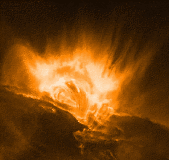 |
Case A:NOAA event listing: [A]; Magnetic environment [A]; RHESSI light curve [A1][A2]; GOES light curve [A];On 21 April 2002, TRACE observed an X1.5 flare in Active Region 9906 at the solar limb. The observations, at a high cadance in 195Å (a mixture of Fe XII at 1.5 million degrees and Fe XXIV at some 10 million degrees) show some remarkable features that have never been seen before this close to the Sun; they can be seen in this (QuickTime/JPEG; 15.8MB) movie (with images rotated so that north is to the left). Between 00:50 and 01:05UT there is a faint brightening that rapidly expands upwards. Then, for about 25 minutes, there is an unusually hazy, striated, rapidly-evolving pattern of emission visible above the active region. Around 01:33UT another new phenomenon is seen: dark blobs move downward into the bright haze. Some look as one might expect for dark, cool material sinking through a hot, tenuous material underneath, with some sign of vortices. The rest of the evolution is more familiar: bright flare ribbons leaving a bright trail of ``prairie fire'', and arcades of cooling loops form, with dark, cooled material draining back towards the solar surface. This running-difference
LASCO movie shows what appear
to be similar infalling clouds, albeit at much greater heights
(from LASCO
web pages at NRL).
|
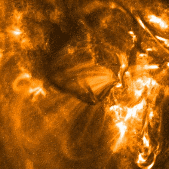 |
Case B:NOAA event listing: [B]; Magnetic environment: [B]; RHESSI light curve [B]; GOES light curve [B];
On 25 August 2003, TRACE observed a filament eruption in Active Region
10442. The (QuickTime; 5.7MB)
movie in 171Å shows
the initial, slow rise of the filament for about half an hour from
the start of the movie at 02 UT. The eruption then becomes
explosive between 02:28 and 02:32 UT. Within that interval,
NOAA logged a GOES C3.6 flare in the region. Notice that the
high filament material can be traced into the upper-left corner until
at least 02:46 UT, where it casts a faint shadow onto the bright loops
behind it. Courtesy: Dawn Myers.
|
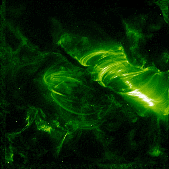
|
Case C:NOAA event listing: [C]; Magnetic environment: [C]; RHESSI light curve [C]; GOES light curve [C];
 : third largest recorded until then (but see the entry above!). : third largest recorded until then (but see the entry above!).The (QuickTime/JPEG; 17.4MB) 3-hr movie in 195Å shows the evolution of the flare: It begins with some compact loops in the center of the field just after 10 UT. That is followed within 15 minutes by several flare ribbons that brighten, and rapid motions and brightenings around the filament towards the lower right. The beginning of the main event complex occurs just as TRACE cannot observe for about 25 minutes; when observing resumes, there is a fuzzy set of loops just left of center. Around 11 UT, many new flare ribbons right of center show up (so bright there are multiple diffraction patterns seen in the images). Again there is an interruption in the TRACE observations: 12 minutes later, a bright post-flare arcade is formed, that cools and drains with time. During that last phase, there is one more period when TRACE cannot observe, because the Earth moves in front of the Sun; the fainter images that beautifully show the cooling arcade when observing resumes, are observed through the Earth's atmosphere. As TRACE moves away from its eclipsed views, the loops brighten again as the Earth's atmosphere blocks less and less of the light. Click
here to access the NASA press release,
here for the ESA press release,
here for the frames from above TRACE movie,
or use these for two other movies:
movie in 195Å (13.7MB),
movie in 1600Å (13.8MB).
|
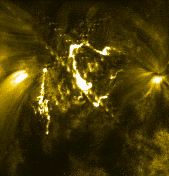 |
Case D:NOAA event listing: [D]; Magnetic environment [D]; RHESSI light curve [D]; GOES light curve [D];
TRACE observed this X1.6 flare in AR 10649 on 2004, July 15. The
(QuickTime/JPEG; 22MB)
171Å movie is rather
unremarkable,
given the magnitude of the flare: there are some compact flare kernels,
and bright flare ribbons, but the ribbons are rather stationary,
and even the post-flare loops are far from spectacular. The
(QuickTime/JPEG; 54MB)
1600Å movie was
interrupted during the main phase of the flare, with a gap from 18:21 UT
through 18:32 UT, giving precendence to the 171Å observations.
|
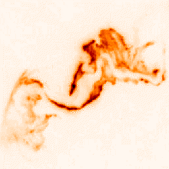 |
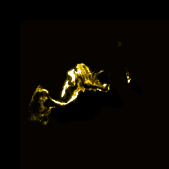
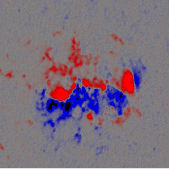
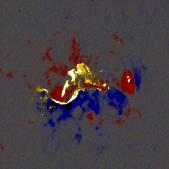
Case E:NOAA event listing: [E]; Magnetic environment [E]; RHESSI light curve [E]; GOES light curve [E];TRACE observed this X2.5 flare in NOAA Active Region 10696 on 2004, November 10. This 55 min. QuickTime/JPEG movie (14.2MB) shows the event as seen in the 1600Å channel at a cadence that is as short as 1.9s during the main eruptive phase of the flare from about 02:04 UT onward. The image on the left shows a negative, logarithmically scaled cutout taken at 02:09:20 UT, zoomed in by a factor of two to reveal the detailed structure. The three images above show the flare at 02:09:20 UT in a different color scale (lag. intensity 95-2000DN), a scaled SOHO/MDI magnetogram (taken at 01:39UT), and a blend of these two images (511x511 pixels of 370km each). The alignment is approximate, moving the images relative to each other until the correspondence appeared optimal. Note that the bright UV regions in over the northern (red) polarity appear to span a gap in the magnetogram; the arch-like structures that connect the extremities of the corresponding emission region appear to reflect the magnetic canopy over a relatively field free patch of the solar surface. Note also that the left-most part of the upper intensity structure (over the red polarity) does not seem to map to an abvious magnetic structure. We are studying how that can be.
For comparison,
the RHESSI light curves for the flare are shown in the image below. |
|
| Home | Mission | Instrument | Team | Operations | Results | Images | Movies | Education | Site Info. | |